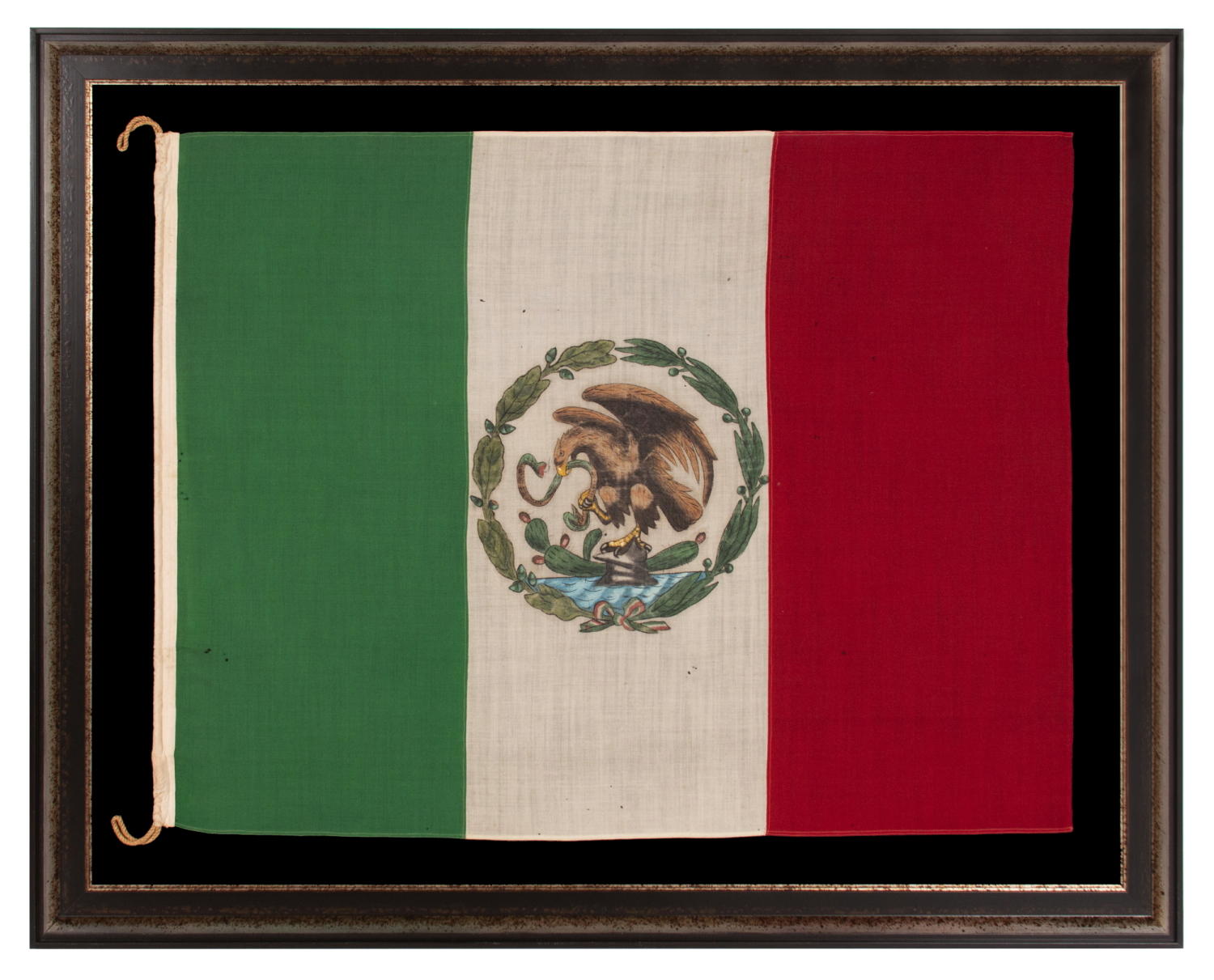


| MEXICAN NATIONAL FLAG IN THE DESIGN USED BY REVOLUTIONARIES FROM 1917 - 1934, THE FIRST PERIOD IN WHICH THE EAGLE WAS ILLUSTRATED IN SIDE VIEW; MADE OF GABARDINE WOOL AND WOOL BUNTING, WITH RICH COLORS AND A HAND-PAINTED DEVICE, USED IN THE LATTER YEARS OF THE ERA OF PONCHO VILLA (b. 1878, d. 1923) |
|
| Web ID: | ofj-995 |
| Available: | In Stock |
| Frame Size (H x L): | 51.25" x 63.25" |
| Flag Size (H x L): | 40" x 51.25" |
| Description: | |
| Flag of Mexico, in the design adopted in 1917 by the revolutionary government, in use until a re-design of the seal took place in 1934. This covered part of the principal era of Francisco "Poncho" Villa. The field is comprised of the expected vertical bars of green, white, and red, with the charge on the white bar. This is the first period in which the device consisted of an eagle in side view, instead of with breast forward. Perched on a rock that protrudes from a body of water, with prickly pear cactus growing outward and upward from each side, the war-like bird grips a rattlesnake in its proper right talon and beak. The image is cradled within an open wreath of oak and laurel branches, tied with a bow at their juncture, in the bottom center. The bow is striped with the national colors. One year before this flag was accepted, in 1916, U.S. President Woodrow Wilson sent General John Pershing to capture Poncho Villa, whose loyalty shifted as he attempted to gain power. The chase ended abruptly in 1917, when the U.S. entered WWI (U.S. involvement 1917-1918). It was in this year that the U.S. recognized the Carranza government of Mexican Revolutionaries, in order to secure a status neutrality for Mexico in the World War. U.S. intervention was a direct consequence of something called the Zimmermann telegram, sent by Germany to Mexico, which proposed a military alliance, in the event that the United States entered the war on the side of the allied forces that stood against it. The design of the flag is very close to others that had been in use since 1821. The tri colors represent the armies of the Three Guarantees, that defeated Spain to secure Mexican independence. Bars representing these were originally set on the diagonal, in February of 1821. In November of that year these were rotated upright. The eagle appeared at the same time, perched on the cactus and wearing a crown. Variations of the eagle have been in use ever since, with the rattlesnake appearing in 1823, just two years after the design’s initial inception. The primary difference between the rattlesnake on the flag that is the subject of this narrative (1917-1934), versus the ones that followed (1934 – present), is that the head is bent downward in the earlier version and arches upward thereafter. Note the rich, saturated colors employed in the flag, the field of which is stitched in three panels. The center bar is made of wool bunting, upon which the device is beautifully hand-painted. The red and green bars to either side are likewise made of wool, but of gabardine as opposed to bunting, with a diagonal, twill weave. The panels were joined with machine stitching, then bound at the top and bottom in the same fashion. There is an oxford woven cotton or linen binding along the hoist, in the form of an open sleeve, applied with machine stitching. Through which a length of hemp rope was passed, looped at the top and bottom, then hand-stitched firmly in place with heavy cotton twine. All-in-all, a beautiful example of the Mexican national colors, with wonderful proportions, a hand-painted seal of very desirable quality, rich hues of red and green, and beautiful fabrics. Mounting: The flag was mounted and framed within our own conservation department, which is led by expert staff. We take great care in the mounting and preservation of flags and have framed thousands of examples. The flag has been hand stitched throughout to 100% silk organza for support, on the reverse. It was then hand-stitched to A background of 100% cotton twill, black in color, that has been washed and treated for colorfastness. The mount was then placed in black-painted, hand-gilded and distressed molding. The glazing is U.V. protective acrylic (Plexiglas). Condition: Overall excellent. There is an extremely minor mothing in limited areas. |
|
| Video: | |
| Collector Level: | Intermediate-Level Collectors and Special Gifts |
| Flag Type: | Sewn flag |
| Star Count: | |
| Earliest Date of Origin: | 1917 |
| Latest Date of Origin: | 1934 |
| State/Affiliation: | |
| War Association: | |
| Price: | Please call (717) 676-0545 or (717) 502-1281 |
| E-mail: | info@jeffbridgman.com |
 |
|